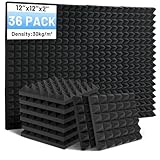This guide will answer what are acoustic foam panels, how they work, how many you need, and how to use them to help with soundproofing your music studio.
What Are Acoustic Foam Panels?
Acoustic foam panels are sound-absorbing panels used to treat the reverberation and reflections in a room. These panels help create a more comfortable environment by diminishing echoes and making speech and other sounds easier to understand.
- What Are Acoustic Foam Panels
- Types Of Acoustic Foam Panels
- How Do Acoustic Foam Panels Work
- Do Acoustic Foam Panels Really Work
- Acoustic Foam vs. Acoustic Panels
- Where Do You Put Acoustic Panels
- How Much Acoustic Foam Do I Need
- Can Acoustic Foam Panels Soundproof
- How To Use Acoustic Foam Panels
- Best Acoustic Foam Panels

What Are Acoustic Foam Panels?
Acoustic foam is used to absorb or diffuse sound waves. It is excellent for soundproofing and helps to reduce echoes and reverberation in a room, making it easier to hear speech or other sounds.
A room with a lot of echoes and reverberation may sound closed-in or echoey. This can be a problem when watching TV or listening to music in a room with poor sound quality and may also contribute to problems with speech intelligibility.
Acoustic foam panels help control and absorb the sound waves so that they do not bounce off surfaces and create echoes and reverberations. This creates a more balanced sound in the room, making speech and music easier to hear and understand.
Acoustic foam has about the same effect when absorbing sound as fiberglass insulation. However, acoustic foam is more attractive in appearance and much easier to install.
How Do You Install Acoustic Foam Panels?
There are a few different ways to install acoustic foam panels, depending on the type of panel and the surface on which you’re installing it.
If you’re installing a foam panel onto a wall, you can use construction adhesive to attach it directly to the wall or use nails or screws to attach it to a wooden frame that is then attached to the wall.
If you’re installing a panel in an open space, such as in a studio or home theater, you can suspend it with wire or hooks from the ceiling.
You can also buy stands that allow you to place the panels on top of furniture or shelves.
Whichever installation method you choose, ensure that the panels are securely attached and there are no gaps between panels.
What Are The Types Of Acoustic Foam Panels?
There are many types of acoustic foam panels, but they all serve the same primary purpose: to reduce noise and reverberation in a room.
Some of the most common types of acoustic foam panels include:
1. Wedge Panels
These panels are triangular in shape and can be mounted on the wall or ceiling. They are effective at absorbing mid to high-frequency sound waves.
2. Corner Bass Traps
These panels are designed to absorb low-frequency sound waves, which often cause reverberation and echo in a room.
3. Foam Tiles
These tiles can be used to cover an entire wall or ceiling, or they can be used as standalone absorbers. They are effective at absorbing mid to high-frequency sound waves.
4. Wall Absorbers
These panels can be mounted on a wall or ceiling. They are good at absorbing mid to high-frequency sound waves.
5. Ceiling Cloud Absorbers
These panels are mounted on the ceiling and can effectively absorb mid to high-frequency sound waves.
Other types of panels may be available depending on your application.
How Do Acoustic Foam Panels Work?
Acoustic foam panels are designed to help control the sound reflected in a room. They do this by absorbing the sound waves that hit them, preventing them from bouncing off the walls and ceilings and creating echoes.
The panels work best when they are placed in positions where they will absorb the most sound. Typically, this means putting them along the walls and in the corners of a room.
You can also use them to cover large open spaces, such as doorways or windows. This allows them to absorb some of the sound waves that generally travel out of the room.
Do Acoustic Foam Panels Really Work?
Acoustic foam panels are designed to help improve the sound quality in a room by absorbing sound waves. The panels work best when used with other soundproofing materials, such as insulation and carpet.
Acoustic foam panels can effectively reduce echoes and reverberation in a room, improving speech and music clarity. They can also help deaden unwanted noise from outside or other building parts.
However, acoustic foam panels are not a substitute for proper insulation and soundproofing, and they will not be effective if there is already significant noise infiltration.
Which Is Better Acoustic Foam Or Acoustic Panels?
There is no one-size-fits-all answer to this question, as the best type of acoustic treatment will vary depending on the room’s size, shape, and layout.
However, in general, acoustic foam is a better option than acoustic panels for smaller rooms, while acoustic panels are generally a better option for larger rooms.
The acoustic foam absorbs sound waves more effectively than acoustic panels, so it is better at reducing echo and reverberation in small spaces.
However, acoustic foam can be pretty expensive if you need to cover a large area. Acoustic panels are less effective at absorbing sound waves than acoustic foam, but they are less costly and can be used to cover a larger area.
Where Do You Put Acoustic Panels?
Depending on the desired effect, you can put acoustic panels in various places. Some people put them in the corners of a room to reduce echo, while others might place them behind furniture to absorb sound.
In general, it’s best to place acoustic panels where they will have the most impact. For example, if you’re trying to reduce echo in a large room, you want to place panels near the walls and ceilings.
However, if you’re trying to absorb sound in a small room, you would want to place them near the source of the noise.
Additionally, if you want to stop the sound from escaping the room, you would like to place acoustic panels on doorways and windows.
How Much Acoustic Foam Do I Need?
The amount of acoustic foam you need will vary depending on the size and shape of the room and how much noise needs to be absorbed.
However, here are a few general guidelines to help you determine how much foam you’ll need:
If you’re trying to absorb low-frequency noise (bass sounds), you’ll need more acoustic foam than if you’re trying to absorb high-frequency noise (treble sounds).
In general, thicker foam pieces will be better at absorbing higher frequencies than thinner pieces of foam.
The room’s surface area will also play a role in determining how much foam you’ll need – for example, a small room would typically need less foam than a large room.
Generally, you should cover 25-40% of the surface area with foam to improve the sound quality. This will vary depending on the type of foam, so you should always follow the manufacturer’s guidelines.
Can Acoustic Foam Panels Soundproof A Room?
Acoustic foam panels can help soundproof a room, but they are not 100% effective.
The best way to soundproof a room is by using a combination of acoustic foam panels and other materials, such as insulation and drywall.
Acoustic foam panels are a good option if you want to soundproof a room on a budget.
However, it is essential to note that they will not be as effective as more expensive methods, such as adding extra insulation to the walls or installing double-pane windows.
How To Properly Use Acoustic Foam Panels?
The use of acoustic foam panels is a popular way to improve the sound quality in a room. However, it’s essential to understand how to use them correctly to get the best results.
First, it’s essential to identify the areas of the room that need the most improvement. The panels should then be placed in these areas. It’s also crucial to make sure that they are correctly installed to do their job correctly.
The next thing is to make sure that you buy the correct type of panels for your needs. Not all panels are created equal, and some are better suited for specific applications than others. For example, if you’re looking to treat noise reverberation, you’ll need panels specifically designed for that purpose.
The next thing to consider is placement. You want to make sure that the panels are placed in such a way as to maximize their effectiveness.
Generally speaking, you’ll want to place them along the walls and ceiling of the room, as well as directly behind any speakers or other sound sources.
It’s also a good idea to check the manufacturer’s recommendations for placement. This will help you get the best results possible.
Related: Best Studio Monitors
Best Acoustic Foam Panels
Here are the most popular items on Amazon.
Last update on 2025-10-28 / Affiliate Disclaimer
I hope you better understand acoustic foam panels and how they can help with better sound quality.











